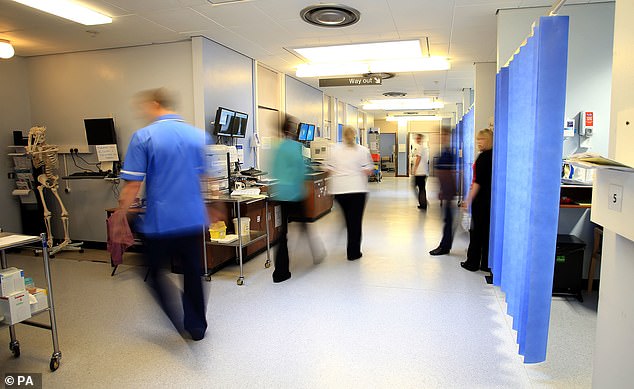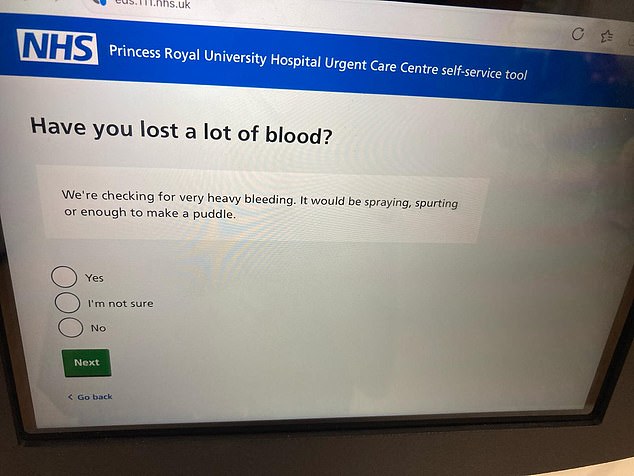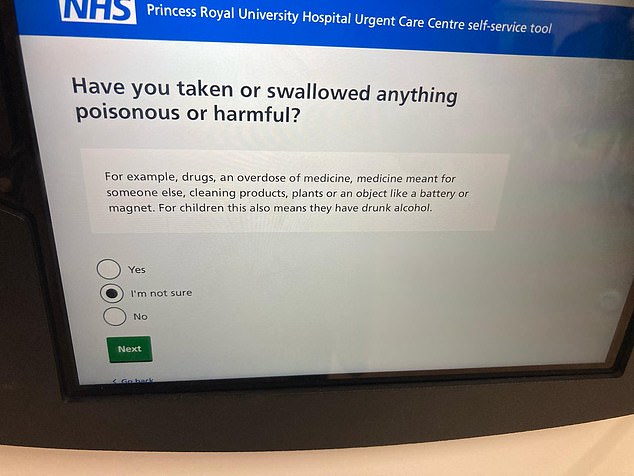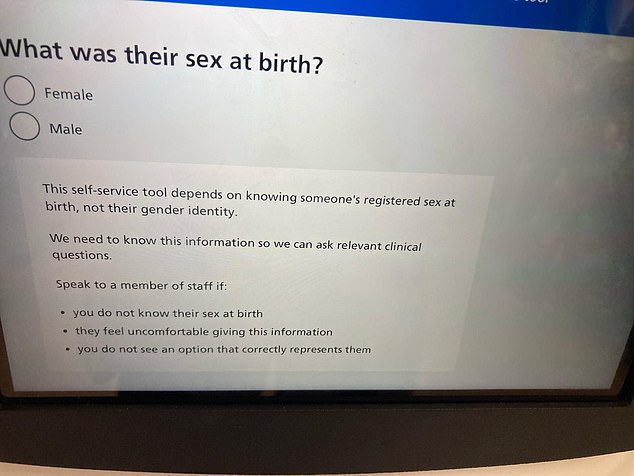Everyone expects a long wait in the ER these days, even if they’re in pain.
But a new plan threatens to add to the agony: an iPad monitoring system that even asks if you’re “dripping” blood before calling a doctor.
Surprisingly, there are 14 pages of multiple-choice questions before patients are asked, “Have you lost a lot of blood?”
Then the screen reads: ‘We are checking for very heavy bleeding. It would be sprays, streams or enough to form a puddle.’
NHS England’s new ‘self-service urgent care centre’ program requires the patient to find the energy to tap on one of the options: Yes, No or Not sure.

NHS England’s new ‘urgent care center self-service’ program requires patients to check themselves in when they arrive at A&E


The questions include one that asks whether the patient has lost “enough blood to form a puddle.”
Anyone who has difficulty breathing has to read the same number of pages before reaching the question: “Do you have sudden, rapid swelling of your lips, face, tongue, mouth or throat?”
And anyone seeking help after attempting suicide has to fill out even more pages before being sternly asked on the computer screen: ‘Are you here because you tried to end your life?’
Only later are they asked: ‘Have you taken or swallowed anything poisonous or harmful? For example, drugs, a medication overdose, medication intended for another person, cleaning products, plants, or an object such as a battery or magnet.’


Patients have to read pages of questions before they are asked if they have swallowed something poisonous or harmful.


Another question is whether the patient has difficulty breathing and has “sudden rapid swelling.”
The new iPad-style emergency devices are already in use across much of south London; The Mail on Sunday found them in operation at Princess Royal University Hospital (PRUH) in Orpington, as well as hospitals in Beckenham and Sidcup, similarly run by King’s College Hospital NHS Trust.
When The Mail on Sunday visited PRUH, two non-medical staff behind a glass partition looked embarrassed when they said those who needed help had to “check themselves in on iPads” in the waiting room, even if they were bleeding.
A non-medical reception staff member at the PRUH told the MoS: ‘Since they arrived a couple of weeks ago, we have been told to send people to the iPads even if they are obviously bleeding.
“We’ve had people bleeding on the ground down there and all kinds of things.”
NHS England, which designed the programme, said hospitals could use it to improve efficiency.
But last night, director of over-60s campaign group Silver Voices, Dennis Reed, said: “I am extremely concerned that self-check-in screens like this in A&E could be dangerous and cause life-threatening delays “.
‘Some patients, including the elderly, will be so stressed or ill when they arrive at A&E that they will not be able to cope with the task of filling out a digital questionnaire.
“The first thing they’ll want to do is talk to a real person, who can ask them what’s wrong and classify them appropriately.”
Registration systems first query the person’s identity, followed by a wordy page asking “What was your sex at birth?” with the answers Man and Woman.
A long explanation follows, saying that the hospital needs to know “someone’s registered sex at birth, not their gender identity,” and suggesting, for the first time, talking to staff “if you don’t see a (sex) option that suits them.” represent correctly.” .


Registration systems first query the person’s identity, followed by a wordy page asking “What was your sex at birth?” with the answers Man and Woman
The patient is then asked if they have booked an appointment, been seen by a doctor, or have recently been to the hospital.
Only then does the screen ask “the reason you are here,” providing options including symptoms or an injury and mental health issues.
Clicking on “Symptoms or an injury” asks “Do you have an injury?”, and “yes” leads to “Have you lost blood?”
Then comes the question of whether his blood is “spraying, gushing, or enough to pool.”
A “yes” belatedly advises a potentially blood-soaked patient to approach the front desk staff directly.
This advice is given to other people only after they have laboriously had the opportunity to tell that their throat is swelling rapidly.
Suicide attempts have even more screen pages before human contact is encouraged.
Dr Tim Cooksley, immediate past president of the Society of Acute Medicine, said: “It would be preferable if we had well-run and adequately staffed emergency departments, where a real person could quickly see patients.”
Last night a PRUH spokesperson said: “Electronic kiosks were introduced at the PRUH last week to reduce waiting times and improve the care experience for patients.”
A spokesperson for NHS England said: “For a small proportion of trusts, a digital kiosk tool is in place to help identify and triage patient symptoms where it is safe to do so.”

